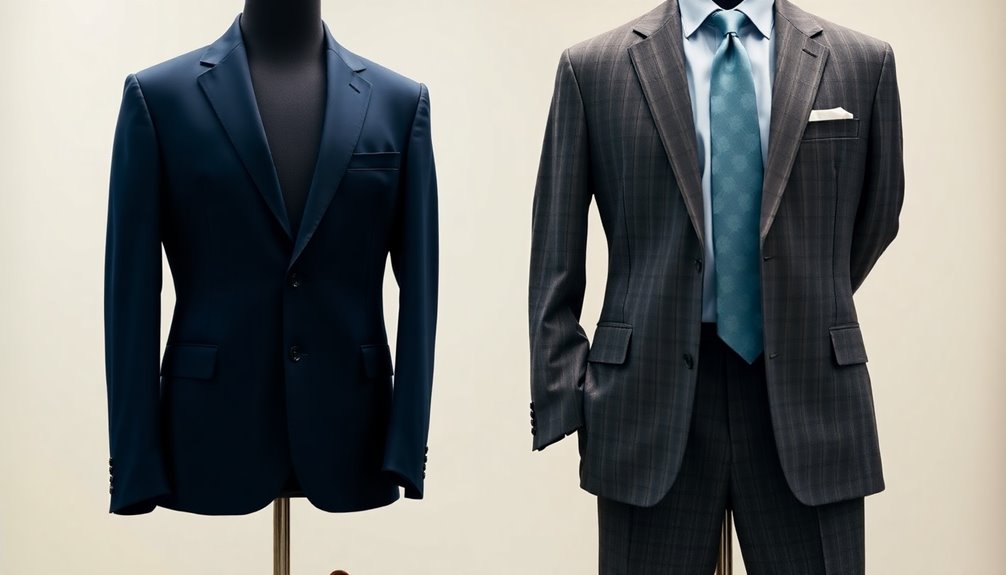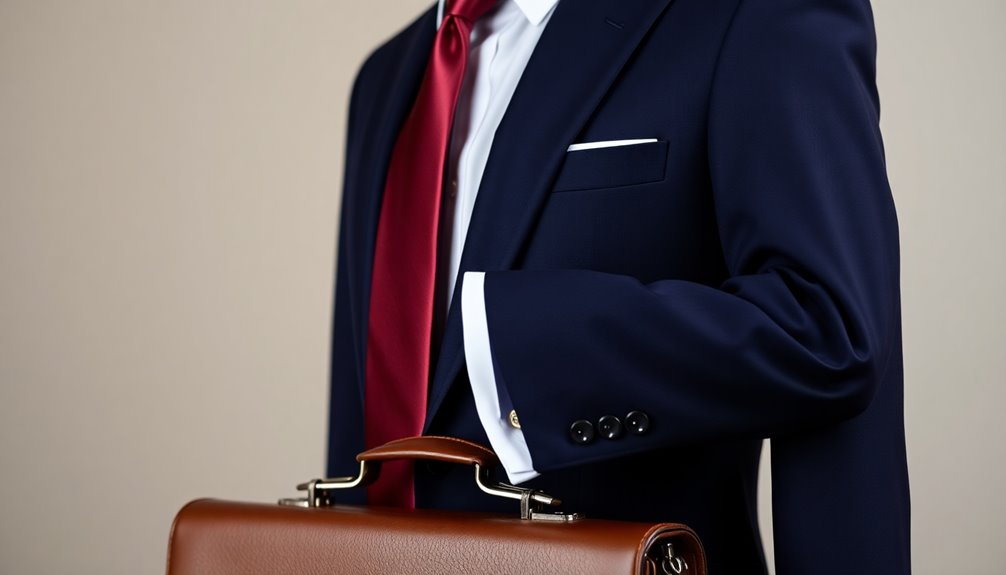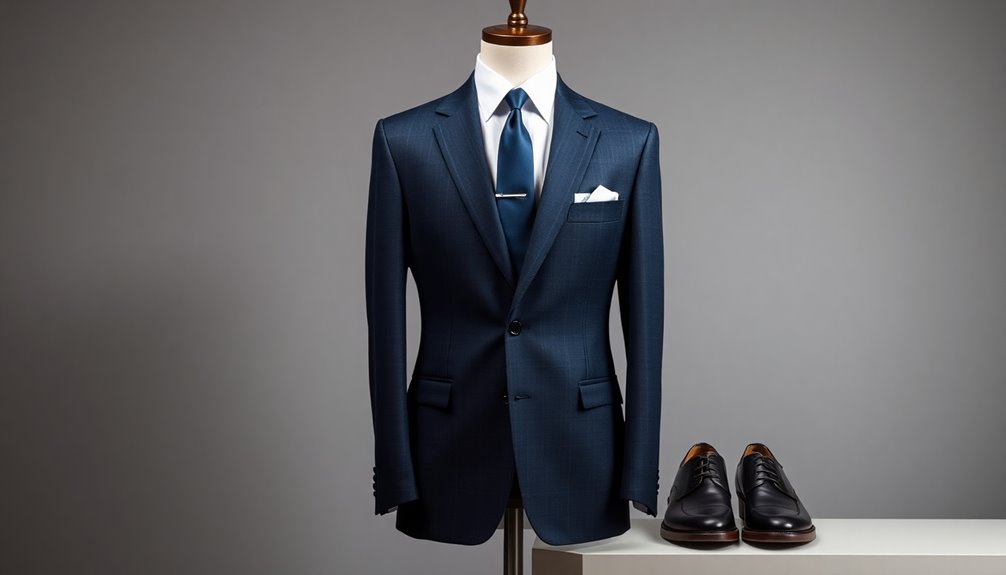A well-fitted suit is your ticket to making instant, winning impressions in any professional setting. You should focus on key fit areas like shoulders, chest, and trouser length for a polished look. Choose versatile colors like navy or charcoal to project trust and authority. Don't forget to accessorize with a classic tie and leather belt for cohesion. Grooming matters too—clean nails and neat hair enhance your overall appearance. With the right suit and attention to detail, you'll exude confidence. Discover more about maximizing your professional attire and the secrets to a standout presence.
Key Takeaways
- A well-fitted suit enhances professionalism, confidence, and overall appearance, making a strong first impression in any setting.
- Choose versatile colors like navy or charcoal to convey trust and authority while maintaining a polished look.
- Invest in quality accessories, such as ties and dress watches, to elevate your professional attire and showcase attention to detail.
- Regular grooming, including haircuts and nail care, is essential for a complete and polished appearance that supports a professional image.
- Budget wisely for suits and accessories, considering options like second-hand suits to achieve a stylish look without overspending.
Importance of a Well-Fitted Suit

When it comes to making a strong impression, a well-fitted suit is key to projecting professionalism and confidence. The fit of your suit can greatly enhance your overall appearance, focusing on important areas like the shoulders, chest, jacket length, sleeve length, and trouser fit. When these elements align perfectly, you'll exude a polished and professional look that's hard to ignore.
It's important to address common misconceptions about pairing different materials, as they can lead to a poorly-coordinated outfit. Understanding the basic components of a suit will help you avoid these pitfalls. Remember, an expensive suit isn't worth much if it doesn't fit well. Consulting professionals for fit adjustments can make all the difference in achieving your desired look.
With a recommended budget ranging from $200 to $2,000, it's vital to take into account both fit and fabric quality to guarantee you're making a good investment. Timeless styles, like a two-button suit in navy or charcoal, offer a wide range of versatility and professionalism, making them ideal choices for anyone looking to create a lasting impression in the workplace.
Choosing the Right Colors

Choosing the right colors for your professional attire can markedly impact how you're perceived in the workplace. Opt for versatile shades like navy, charcoal, and gray. These colors exude professionalism and fit well in various settings. If you want to add a fresh touch, consider lighter shades such as light blue or beige, especially in warmer months.
Understanding color psychology also plays a significant role. For instance, blue is linked to trust and reliability, while black conveys authority and sophistication. Using these colors strategically can elevate your professional image. Additionally, monochromatic looks—pairing different shades of the same color—create a sleek and polished appearance, which feels modern yet professional. Selecting attire with water efficiency features can also reflect a commitment to sustainability in the workplace.
It's essential to avoid overly bright or flashy colors in business settings. Such hues can be distracting and may not conform to traditional professional dress codes. Instead, focus on creating a cohesive look that showcases your professionalism while allowing your personality to shine through. By choosing the right colors, you not only enhance your appearance but also instill confidence in those around you, making a lasting impression in your professional environment.
Understanding Suit Types

When you're selecting a suit, it's crucial to understand its components and the different types available. A suit usually consists of a matching jacket and trousers, but you'll find options like bespoke, custom, and off-the-rack suits that cater to various needs and budgets. By knowing the distinctions and focusing on fit, you can make a choice that elevates your professional appearance.
Suit Components Explained
Understanding the various components of a suit can greatly enhance your professional appearance. A suit typically includes a matching jacket and trousers made from the same material, setting it apart from blazers or sports jackets that often pair with casual trousers.
When choosing a suit, consider the fit as it's essential for a polished look. Focus on key areas like shoulder fit, chest fit, jacket length, sleeve length, and trouser fit. A well-fitted suit elevates your overall image.
Quality matters too. High-quality suits are often made from 100% wool, with the fabric's tightness indicated by "super numbers" like super 100 or super 180, reflecting the material's durability. For versatility, stick to classic colors like navy, charcoal, or gray. These shades work well for various professional settings.
Lastly, timeless styles—such as two-button suits with notch lapels—remain favored for their classic appeal. By understanding these components, you can make informed choices that not only look great but also help you stand out in the professional world.
Types of Suits
Suits come in various types, each designed to cater to different occasions and personal styles. Understanding the differences can help you choose the right one for your needs.
- Bespoke Suits: Custom-made and crafted from high-quality materials, these suits offer an unparalleled fit and style.
- Custom Suits: Tailored to your specific measurements, custom suits provide a balance between personal fit and affordability.
- Off-the-Rack Suits: These suits are ready-made and available in stores, making them a practical and budget-friendly option.
Regardless of the type, proper fit is key. Focus on essential areas like shoulder fit, chest fit, jacket length, sleeve length, and trouser fit to enhance your overall look. For materials, 100% wool is recommended, with tighter fabrics indicated by super numbers—higher numbers mean finer fabric. When it comes to color, versatile choices like navy, charcoal, and gray are ideal, and timeless styles such as two-button jackets suit various settings perfectly.
Essential Accessories for Impact

A well-chosen tie or pocket square can transform a simple suit into a statement of style and professionalism. These accessories add personality and sophistication, making your outfit memorable. Opt for ties and pocket squares that complement your suit while reflecting your personal taste.
Don't forget about your belt; a classic leather belt matching your shoe color is crucial for a cohesive appearance. This small detail guarantees your outfit feels intentional and polished.
A dress watch is another essential accessory. Choose a simple, elegant design that enhances your professionalism without overshadowing your suit. Timeless styles work best and can be a subtle conversation starter.
When it comes to jewelry, keep it understated. A single ring or a pair of stud earrings can maintain a professional image while allowing for personal expression. Additionally, consider incorporating personalized gifts that can make your style truly unique and memorable.
Grooming for a Polished Look

To make a strong impression, you can't overlook the importance of nail care and hair maintenance. Keeping your nails clean and trimmed, along with a well-groomed beard or hairstyle, shows attention to detail and professionalism. When you prioritize these grooming essentials, you not only enhance your appearance but also boost your confidence in any business setting. Additionally, investing in quality styling products tailored to your hair type can significantly improve your overall look.
Nail Care Essentials
Nail care is an essential part of your grooming routine that can greatly impact your professional image. When you're preparing for interviews or networking events, clean and well-groomed nails can enhance your overall professionalism. Here are some key practices to keep in mind:
- Trim Regularly: Maintain your nails at a moderate length. Overly long or uneven nails can create a negative impression.
- Smooth Edges: Use a nail file to smooth out any rough or jagged edges. This attention to detail shows you care about your appearance.
- Moisturize: Regularly moisturizing your hands will improve the look of both your nails and skin, guaranteeing they appear healthy and well-cared for.
For an extra touch, consider applying a clear or neutral nail polish. This provides a subtle shine and protects your nails while remaining suitable for various business settings. Additionally, keeping your nails well-groomed can help avoid any potential skin irritation or allergic reactions related to essential oil use. By incorporating these nail care essentials into your routine, you'll guarantee that every aspect of your appearance reflects professionalism, helping you make a lasting impression. Remember, a polished look can be the deciding factor in winning offers!
Hair and Beard Maintenance
Maintaining a polished look involves more than just clean nails; hair and beard grooming play an important role in your overall presentation. Regular grooming is key, so aim for haircuts every 4-6 weeks to keep your style fresh and professional. A well-maintained haircut complements your outfit and boosts your confidence.
For your beard, trimming is vital to avoid an unkempt appearance. Focus on creating a sharp, defined shape by paying attention to the neckline and cheek lines. This detail enhances your look, especially when paired with a suit.
Cleanliness matters, too. Regularly wash and condition your hair and beard to prevent dandruff and promote a healthy shine. This not only looks good but also makes a positive impression in professional settings.
Invest in quality grooming products like beard oils and pomades; they can greatly enhance the health and appearance of your hair and facial hair. Additionally, practicing deep breathing techniques can help reduce stress, making your grooming routine more enjoyable and effective. Finally, keep your grooming tools—clippers, trimmers, and combs—in good condition and use them regularly. These small efforts guarantee you maintain an attractive, polished look that stands out in any professional environment.
Suit Etiquette and Best Practices

A well-chosen suit can make all the difference in how you're perceived in professional settings. Understanding suit etiquette is essential for creating a positive impression. First, make certain you know the distinction between casual and formal attire. Choosing the right outfit for the occasion is key.
Here are some best practices to keep in mind:
- Fit Matters: A well-fitted suit enhances your appearance. Pay close attention to the fit across the shoulders, chest, and trouser length to avoid common style mistakes.
- Accessorize Wisely: Keep your accessories complementary. Opt for muted jewelry and classic cufflinks to maintain a polished look without being overly flashy.
- Grooming Counts: Details like clean nails, neat hair, and overall hygiene contribute greatly to your first impression. Regular maintenance can also extend appliance lifespan and ensure that your home environment supports your professional demeanor.
Familiarize yourself with timeless styles, such as two-button suits and notch lapels, which are versatile and professional. By following these guidelines, you'll position yourself as someone who respects the nuances of professional attire, ultimately helping you stand out in the best way possible.
Budgeting for Your Wardrobe

Strategic budgeting is vital when building your professional wardrobe. A quality suit typically costs between $200 and $2,000, depending on the fabric and brand. If you're eyeing high-end options, be prepared to spend over $3,000 at renowned tailors. Besides the suit, you should budget for complementary items like dress shirts, ties, and shoes, which can add another $200 to $600 to your expenses.
To make informed budgeting decisions, start by evaluating your average monthly salary. This helps you allocate a reasonable percentage toward professional attire without sacrificing other financial responsibilities. Online shopping can be a great way to find a wider selection and often better prices. However, don't overlook offline shopping, as it allows for immediate access and personalized fitting, which can be essential for a polished look.
If you're just starting out and want to save, consider seeking second-hand or donated suits from friends and family. This can greatly reduce your initial investment while still helping you look sharp. By planning wisely, you'll build a wardrobe that enhances your professional image without breaking the bank. Additionally, it's important to create a budget plan to ensure all expenses align with your financial goals.
Maximizing Confidence in Interviews

Dressing well can make a significant difference in how you feel during interviews. A well-fitted suit doesn't just improve your appearance; it enhances your confidence. Studies show that 93% of first impressions rely on appearance and body language, so looking sharp is essential. When you invest in your professional wardrobe, like participants from the UTC Suit Up event who felt more prepared and self-assured after updating their attire, you're setting yourself up for success.
Here are a few tips to maximize your confidence during interviews:
- Choose well-fitted clothing: Tailored suits make you look polished and feel more self-assured.
- Engage in personalized styling: Attend events like Suit Up for tailored advice that aligns your wardrobe with your career goals.
- Dress for success: Research indicates that wearing professional clothing can enhance cognitive processes, boosting your performance during high-stakes situations. Additionally, studies suggest that dressing professionally can positively impact first impressions, which is crucial in interview settings.
Frequently Asked Questions
How Many Suits Should I Own if I Wear One Everyday?
If you wear a suit every day, you should own at least 3 to 5 suits. This gives you enough variety for rotation and helps prevent wear and tear. Aim for a mix of colors like navy, charcoal, and gray to adapt to different settings. Pair each suit with 2 to 3 dress shirts and ties for versatility. Don't forget to incorporate seasonal fabrics for comfort throughout the year!
How Many Suits Does the Average Man Own?
The average man owns about 3 to 5 suits, giving you the flexibility you need for various professional settings. This range allows you to mix and match while keeping your wardrobe manageable. If you're in a field like finance or law, you might find yourself owning more than five. It's also common for men to buy a new suit every couple of years, especially during significant life events or career changes.
How Many Days in a Row Can You Wear a Suit?
You could wear a suit for three consecutive days without smelling like a gym bag, as long as you air it out and treat it well! Factors like fabric type and climate play a role, too. For best results, let your suit rest for 24 hours between wears to keep it fresh and maintain its shape. Rotating between multiple suits can also help extend their lifespan and keep you looking sharp.
Conclusion
In summary, a well-fitted suit, the right colors, and essential accessories can elevate your professional image. By understanding suit types, maintaining grooming standards, and following etiquette, you'll project confidence and competence. Budgeting wisely for your wardrobe guarantees you invest in quality pieces that last. So, suit up, stand tall, and step into your next opportunity with assurance. Remember, it's not just about looking good; it's about feeling empowered and ready to conquer the day!
Felicity, our Author, pens in-depth articles and guides that delve into the heart of personal discovery. Her narrative-driven approach weaves together theory, practice, and personal anecdotes, making the journey of self-exploration both relatable and inspiring. Felicity’s contributions help illuminate the path for those seeking a deeper understanding of themselves and their relationships.










